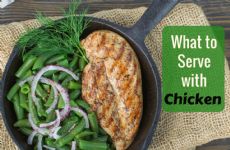|
Just like the boy of the same name would say, buckwheat is o-tay! I recently became a big fan of the triangular grain that is growing in popularity. Buckwheat is actually not part of the wheat family, which means it is gluten free. It also provides eight amino acids, plus plenty of fiber and protein. To learn more about this unfamiliar, trendy grain, I phoned my agriculture expert. He is actually on my speed dial under "Daddy." Turns out, my dad has been growing buckwheat for years, which was a surprise for me. I know the farm and its fields well, and he has never mentioned buckwheat! Part of the reason I had never heard of the harvest was that my family does not harvest the crop. My Dad grows it as a source of food for the deer and doves that call our farm home as well. Buckwheat, as my Dad explained, is a short crop that does not require pesticides or fertilizers. Because it is a short crop, meaning that the plant matures in about 30 days, farmers can come in after its harvest or consumption from animals and then plant a second crop during the same season. The short season makes it perfect for climates with shorter growing seasons like the upper Midwest of the United States. Most of the Buckwheat that is grown in the United States actually gets exported to China to be milled into buckwheat flour used for soba noodles. (While I don't have any soba noodle recipes on SparkRecipes--yet!--you could use them in my chicken or pork stir-fries.) Stop by your local health food store or bulk section and pick up some buckwheat kernels (sometimes called kasha) or buckwheat flour. You can purchase kernels plain or roasted. Take the kernels and transform them into a high-fiber and protein-rich breakfast cereal by just adding some simple and flavorful ingredients you probably already have in your pantry. Check out my recipe for Roasted Buckwheat Breakfast, which can be eaten cold (my favorite way!) or hot, which is perfect for a cold morning. Stepfanie created a raw granola using buckwheat, too. Store the kernels in a cool, dry place away from light, and use them within six months. Some like buckwheat hot, and some like it cold. I love it cold with skim milk and blueberries. Try it either way, but be ready for different tastes and textures. The cold variety will crunch and pop in your mouth and you will taste a roasted nut with a hint of cinnamon and date sweetness. Cooked and served hot, the texture is smooth like porridge, the fruit softens, and the cinnamon takes on a louder note. (No need for additional sugar because the dried dates are so sweet.) Try incorporating buckwheat flour into your baked goods for a boost of nutrition and nutty flavor. Just remember: Buckwheat does not contain gluten, which is what helps wheat flour "stick," so you can't swap all the wheat flour for buckwheat in a recipe. My rule is: Substitute up to 1/3 of the wheat flours for buckwheat flour. The shelf life is about the same as whole wheat flour. If you are not planning to use the flour within 2 months, store it in the freezer. Beyond breakfast and baked goods, add roasted buckwheat kernels to salads or sprinkle over fruit at lunch, or simmer them in soups or stews at dinner time. Due to its high levels of protein and fiber you will find that it sticks to your belly! You'll be full for hours and hours. Nutrition info for 1/2 cup: Calories 291.6 Total Fat 2.9 g Sodium 0.9 mg Potassium 391.0 mg Total Carbohydrates 60.8 g Dietary Fiber 8.5 g Protein 11.3 g Vitamin B-6 8.9 % Vitamin E 4.4 % Calcium 1.5 % Copper 46.8 % Folate 6.4 % Iron 10.4 % Magnesium 49.1 % Niacin 29.8 % Riboflavin 21.3 % Zinc 13.6 % Want more healthy recipes from me and fellow SparkPeople members? Be sure to subscribe to SparkPeople's Recipe of the Day email. Click here to sign up! Did you know SparkRecipes is now on Facebook? Click here to "Like" us! Like this recipe? Then you'll love "The SparkPeople Cookbook: Love Your Food, Lose the Weight." |
Related EntriesMore From SparkPeople
|


















.jpg)

.jpg)

.jpg)